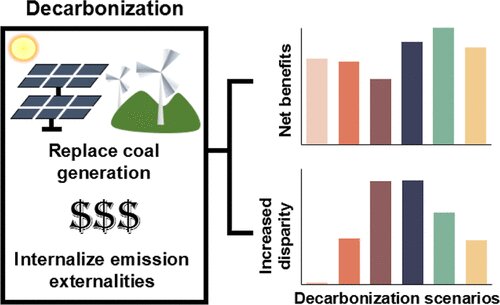Staff Writer

Fayette coal-fired power plant in Texas, USA. (Reference image by Larry D. Moore, Wikimedia Commons.)
A new study drawing on data from some southern states in the US found that the most common strategies for reducing greenhouse gas emissions from power generation also produce enough health benefits to completely offset the cost of these decarbonization efforts. However, while Black and low-income communities also benefit, they still face higher levels of air pollution and related health effects.

The research, led by a team at North Carolina State University, took a closer look at how health benefits associated with decarbonization can inform operational decisions in the power sector.
“If we can determine which specific plants are having the greatest impact on human health, and when, then power systems can modify power generation at those plants to reduce human health impacts,” said Jeremiah Johnson, co-author of the paper that explains the findings.

(Graph from Environmental Science & Technology).
In detail, Johnson and his colleagues evaluated the impacts of six decarbonization strategies. Three strategies involved using different power generation methods to replace coal-fired power plants: solar power, wind power and natural gas. Two of the strategies involved implementing carbon taxes at different levels—effectively increasing the costs of electricity generation based on the amount of carbon dioxide that power plants emit.
The sixth strategy involved requiring power plant operators to include the economic costs of health effects caused by emissions in their decision-making. The carbon tax and health damages strategies would significantly increase the expense of coal power, indirectly encouraging a shift to power generation that produces fewer emissions.
The data
The researchers drew on power generation data from across Texas, as well as health data from Texas and other states affected by air emissions from Texas’s power plants. The data was fed into an integrated suite of new and existing computational models to better understand the health effects of the various decarbonization strategies at the local level.
“We were able to assess health impacts at the census tract level, which is fairly granular—each tract represents between 1,200 and 8,000 people,” Qian Luo, first author of the paper, said. “Specifically, we drew on established studies to determine the extent to which air pollution was contributing to mortality numbers in each tract.”
By calculating the number of deaths associated with the relevant air pollution, the researchers were able to determine the monetized benefits of reducing that air pollution. This was done using the “value of a statistical life,” which is used by the federal government to perform cost-benefit analyses.
In detail, Johnson and his colleagues evaluated the impacts of six decarbonization strategies. Three strategies involved using different power generation methods to replace coal-fired power plants: solar power, wind power and natural gas. Two of the strategies involved implementing carbon taxes at different levels—effectively increasing the costs of electricity generation based on the amount of carbon dioxide that power plants emit.
The sixth strategy involved requiring power plant operators to include the economic costs of health effects caused by emissions in their decision-making. The carbon tax and health damages strategies would significantly increase the expense of coal power, indirectly encouraging a shift to power generation that produces fewer emissions.
The data
The researchers drew on power generation data from across Texas, as well as health data from Texas and other states affected by air emissions from Texas’s power plants. The data was fed into an integrated suite of new and existing computational models to better understand the health effects of the various decarbonization strategies at the local level.
“We were able to assess health impacts at the census tract level, which is fairly granular—each tract represents between 1,200 and 8,000 people,” Qian Luo, first author of the paper, said. “Specifically, we drew on established studies to determine the extent to which air pollution was contributing to mortality numbers in each tract.”
By calculating the number of deaths associated with the relevant air pollution, the researchers were able to determine the monetized benefits of reducing that air pollution. This was done using the “value of a statistical life,” which is used by the federal government to perform cost-benefit analyses.
Low-income and Black neighbourhoods
The researchers found that all six decarbonization strategies reduced adverse health effects from air pollution more than enough to offset the cost of implementing the strategy.
However, while there were health benefits across the board, some areas still suffered from more air pollution than others. These areas tended to be low-income areas or neighbourhoods with large Black populations.
For example, the gap between Black neighbourhoods and other neighborhoods either stays the same or gets worse. In other words, while Black communities benefit from decarbonization, they don’t benefit as much as other neighborhoods. And the same holds true for low-income neighbourhoods across all races.
The researchers said that the findings were also sufficiently precise, pointing to specific emissions from specific plants at specific times, to inform operation decisions that could reduce human health impacts even if the plants are not taken completely offline.
“The takeaway message here is very simple: reducing coal power generation has significant, immediate health benefits,” Johnson said. “And all of the techniques under consideration for reducing coal power generation produce meaningful benefits.”
No comments:
Post a Comment